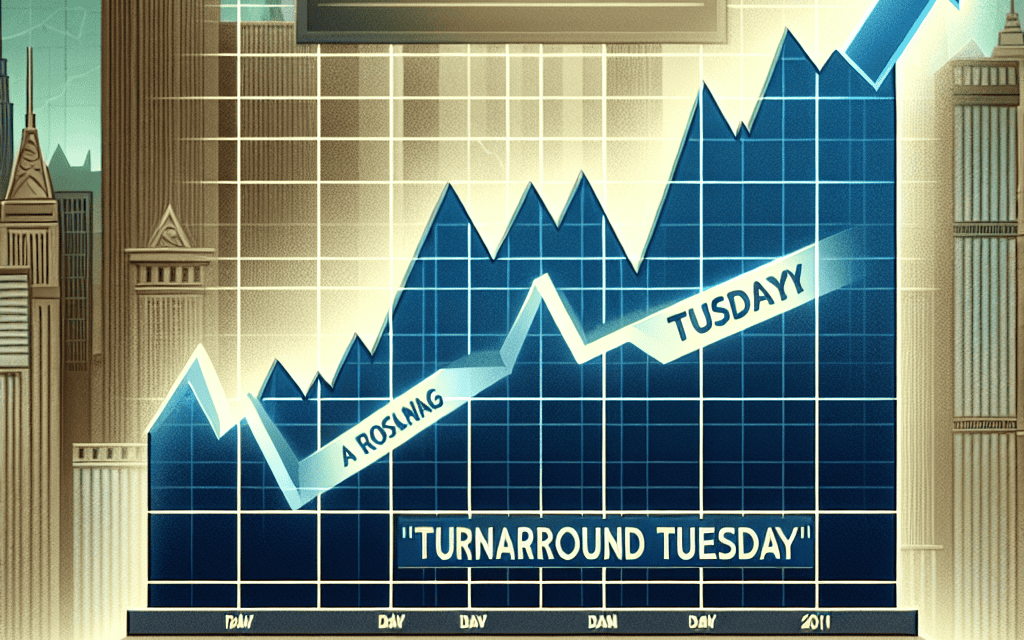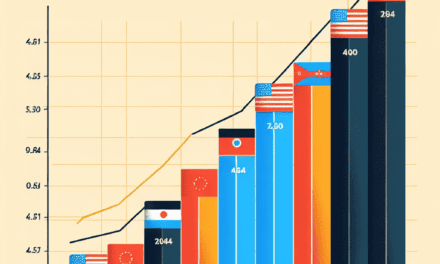“Wall Street Bounces Back: A Turnaround Tuesday Triumph”
Introduction
On “Turnaround Tuesday,” Wall Street experienced a notable rebound, reversing recent downward trends and injecting a sense of optimism among investors. This market recovery was characterized by a surge in major stock indices, driven by a combination of positive economic data, corporate earnings reports, and investor sentiment. The rebound followed a period of volatility and uncertainty, as market participants navigated concerns over inflation, interest rates, and geopolitical tensions. The day’s gains were broad-based, with technology, financial, and consumer sectors leading the charge, reflecting renewed confidence in the resilience of the U.S. economy. As investors assessed the implications of the day’s developments, “Turnaround Tuesday” served as a reminder of the market’s dynamic nature and the potential for swift recoveries amidst challenging conditions.
Understanding ‘Turnaround Tuesday’: A Historical Perspective
The phenomenon known as “Turnaround Tuesday” has long intrigued investors and analysts alike, offering a glimmer of hope during volatile market conditions. Historically, this term refers to the tendency of stock markets to recover on Tuesdays following a downturn earlier in the week. This pattern, while not guaranteed, has been observed frequently enough to earn its own moniker, suggesting that Tuesdays may hold a unique place in the weekly trading cycle.
To understand the origins of “Turnaround Tuesday,” it is essential to consider the psychological and strategic behaviors of market participants. Mondays often set the tone for the week, with investors reacting to news and events that occurred over the weekend. This can lead to heightened volatility and, at times, a negative start to the trading week. However, by Tuesday, investors have had the opportunity to digest the initial shock, reassess their strategies, and make more informed decisions. This recalibration can lead to a reversal of fortunes, as market participants seek to capitalize on perceived opportunities or correct overreactions from the previous day.
Moreover, the concept of “Turnaround Tuesday” is supported by historical data, which shows a tendency for markets to perform better on Tuesdays compared to other days of the week. This pattern can be attributed to several factors, including the release of economic data and corporate earnings reports, which often occur early in the week. These releases provide fresh insights into the health of the economy and individual companies, prompting investors to adjust their positions accordingly. Additionally, institutional investors, who play a significant role in market movements, may use Mondays to evaluate their portfolios and implement changes on Tuesdays, further contributing to the turnaround effect.
While the notion of “Turnaround Tuesday” offers a fascinating glimpse into market dynamics, it is important to approach it with a degree of skepticism. Markets are influenced by a myriad of factors, including geopolitical events, monetary policy decisions, and investor sentiment, all of which can disrupt established patterns. Therefore, while Tuesdays may historically show a propensity for recovery, they are not immune to broader market forces that can lead to continued volatility.
In recent years, the advent of algorithmic trading and the increasing influence of global markets have added layers of complexity to the “Turnaround Tuesday” phenomenon. Algorithms, which execute trades based on pre-set criteria, can amplify market movements, both positive and negative, making it more challenging to predict outcomes based solely on historical patterns. Furthermore, the interconnectedness of global markets means that events in one region can have ripple effects across the world, potentially overshadowing the traditional Tuesday recovery.
In conclusion, “Turnaround Tuesday” remains a compelling aspect of market behavior, offering insights into the interplay between investor psychology and market dynamics. While historical data supports the notion of a Tuesday rebound, it is crucial for investors to remain vigilant and consider the broader context in which these patterns occur. By understanding the factors that contribute to this phenomenon, market participants can better navigate the complexities of the financial landscape, making informed decisions that align with their investment objectives. As with any market trend, a balanced approach that considers both historical patterns and current conditions will serve investors well in their pursuit of financial success.
Key Factors Driving Wall Street’s Rebound
Wall Street experienced a notable rebound on what traders have come to call ‘Turnaround Tuesday,’ a phenomenon where markets often recover from a sluggish start to the week. This particular Tuesday saw a confluence of factors that contributed to the positive shift in investor sentiment, leading to a significant uptick in major indices. Understanding these key factors provides insight into the dynamics that drive market movements and the underlying economic conditions influencing investor behavior.
To begin with, one of the primary catalysts for the rebound was the release of favorable economic data. Reports indicating stronger-than-expected consumer spending and robust retail sales figures helped alleviate concerns about a potential economic slowdown. These data points suggested that consumer confidence remains resilient, providing a solid foundation for economic growth. As consumer spending accounts for a substantial portion of economic activity, its strength is often viewed as a bellwether for the overall health of the economy. Consequently, investors were encouraged by the prospect of sustained economic expansion, prompting a shift towards riskier assets.
In addition to positive economic indicators, corporate earnings played a pivotal role in boosting market confidence. Several high-profile companies reported better-than-anticipated quarterly results, underscoring the resilience and adaptability of businesses in navigating a challenging economic landscape. These earnings reports not only exceeded analysts’ expectations but also provided optimistic forward guidance, further bolstering investor sentiment. As earnings season progresses, the market’s focus on corporate performance highlights the importance of individual company fundamentals in shaping broader market trends.
Moreover, geopolitical developments contributed to the market’s upward trajectory. Recent diplomatic efforts aimed at de-escalating tensions in key regions provided a sense of relief to investors wary of potential disruptions to global trade and economic stability. The easing of geopolitical risks often leads to a reduction in market volatility, encouraging investors to re-enter the market with renewed confidence. This renewed optimism was reflected in the increased demand for equities, driving prices higher across various sectors.
Another significant factor influencing the market rebound was the monetary policy stance of central banks. Recent statements from Federal Reserve officials indicated a commitment to maintaining accommodative monetary policies to support economic recovery. The assurance of continued low interest rates and potential further stimulus measures provided a favorable backdrop for equities, as investors anticipated a prolonged period of liquidity and support for financial markets. This dovish stance by central banks has historically been a key driver of market rallies, as it lowers borrowing costs and encourages investment in riskier assets.
Furthermore, technical factors also played a role in the market’s recovery. After a period of consolidation and downward pressure, technical indicators suggested that stocks were oversold, creating an attractive entry point for investors. The subsequent buying activity helped propel the market higher, as traders capitalized on perceived value opportunities. This technical rebound was further amplified by algorithmic trading strategies that responded to these signals, adding momentum to the upward movement.
In conclusion, Wall Street’s rebound on ‘Turnaround Tuesday’ was driven by a combination of favorable economic data, strong corporate earnings, easing geopolitical tensions, supportive monetary policy, and technical factors. Each of these elements contributed to a renewed sense of optimism among investors, highlighting the complex interplay of factors that influence market dynamics. As the week progresses, market participants will continue to monitor these key drivers, assessing their potential impact on future market trends and investment strategies.
Top Gainers and Losers: A Closer Look at Market Movers
On what has been dubbed ‘Turnaround Tuesday,’ Wall Street experienced a notable rebound, offering a reprieve from the recent volatility that has characterized the financial markets. This resurgence was marked by a mix of optimism and strategic repositioning by investors, who were keen to capitalize on the shifting economic landscape. As the trading day unfolded, a closer examination of the top gainers and losers provided valuable insights into the underlying dynamics driving market movements.
Among the top gainers, technology stocks led the charge, buoyed by renewed investor confidence in the sector’s growth prospects. Companies such as Apple and Microsoft saw their shares rise significantly, driven by strong quarterly earnings reports that exceeded analysts’ expectations. This positive performance was further bolstered by robust demand for their products and services, which has remained resilient despite broader economic uncertainties. Additionally, the tech sector benefited from a favorable regulatory environment, as recent policy announcements suggested a more balanced approach to oversight, alleviating some of the concerns that had previously weighed on investor sentiment.
In contrast, the energy sector faced headwinds, with several major players landing among the day’s top losers. The decline in energy stocks was primarily attributed to fluctuating oil prices, which have been impacted by a complex interplay of global supply and demand factors. Geopolitical tensions and production adjustments by key oil-producing nations have contributed to this volatility, creating an uncertain outlook for the sector. Consequently, companies like ExxonMobil and Chevron experienced declines in their stock prices, reflecting investor apprehension about the sector’s near-term prospects.
Meanwhile, the financial sector displayed a mixed performance, with some institutions emerging as winners while others struggled to maintain their footing. Banks that reported strong earnings, driven by higher interest rates and increased lending activity, saw their shares rise. However, those with significant exposure to volatile markets or underperforming assets faced challenges, resulting in a divergence in performance within the sector. This disparity underscores the importance of strategic positioning and risk management in navigating the current financial landscape.
Consumer discretionary stocks also made notable gains, as investors showed renewed interest in companies poised to benefit from shifting consumer behaviors. Retailers and e-commerce platforms, in particular, experienced a surge in stock prices, driven by strong sales figures and optimistic forecasts for the upcoming holiday season. This sector’s resilience highlights the adaptability of businesses in responding to changing consumer preferences and the potential for growth in an evolving market environment.
As the day drew to a close, the overall market rebound on ‘Turnaround Tuesday’ reflected a complex interplay of factors, including corporate earnings, economic indicators, and geopolitical developments. Investors appeared to be cautiously optimistic, balancing short-term uncertainties with long-term growth prospects. This sentiment was evident in the diverse performance of different sectors, each influenced by its unique set of challenges and opportunities.
In conclusion, the market movements observed on ‘Turnaround Tuesday’ underscore the dynamic nature of Wall Street, where fortunes can shift rapidly in response to a myriad of influences. By closely examining the top gainers and losers, investors can gain a deeper understanding of the forces shaping the market and make more informed decisions. As the financial landscape continues to evolve, staying attuned to these developments will be crucial for navigating the complexities of investing in today’s world.
Investor Sentiment: How ‘Turnaround Tuesday’ Impacts Market Psychology

Investor sentiment plays a crucial role in the dynamics of financial markets, often dictating the ebb and flow of stock prices. One phenomenon that encapsulates this sentiment is the so-called ‘Turnaround Tuesday,’ a term used to describe the tendency for markets to recover after a weak start to the week. This pattern, while not guaranteed, has been observed frequently enough to become a part of market vernacular, influencing both individual and institutional investors. Understanding how ‘Turnaround Tuesday’ impacts market psychology requires a closer examination of the factors that contribute to this recurring event.
To begin with, the concept of ‘Turnaround Tuesday’ is rooted in the psychological behavior of investors. After a weekend break, markets often open on Monday with a degree of uncertainty. This uncertainty can be attributed to a variety of factors, including geopolitical events, economic data releases, or corporate earnings reports that may have emerged over the weekend. Consequently, investors may react with caution, leading to a subdued or negative market performance at the start of the week. However, as the week progresses, investors have more time to digest the information and reassess their strategies, often resulting in a more optimistic outlook by Tuesday.
Moreover, the role of institutional investors cannot be overlooked in this context. These large players, such as mutual funds and hedge funds, often engage in strategic buying or selling based on their analysis of market conditions. On Mondays, they may adopt a wait-and-see approach, holding back on significant trades until they have a clearer picture of the market landscape. By Tuesday, with more data and analysis at their disposal, these institutions may decide to make substantial moves, thereby contributing to a market rebound. This behavior can create a ripple effect, encouraging other investors to follow suit, further amplifying the turnaround.
In addition to institutional behavior, technical factors also play a part in ‘Turnaround Tuesday.’ Many traders rely on technical analysis to make decisions, using charts and patterns to predict future price movements. If a market decline on Monday pushes stocks to key support levels, technical traders may see this as a buying opportunity, prompting a wave of purchases that can drive prices higher. This technical buying can coincide with improved sentiment, reinforcing the turnaround effect.
Furthermore, media coverage and analyst commentary can significantly influence investor sentiment. A negative start to the week often prompts analysts to provide insights and forecasts, which can either alleviate or exacerbate investor concerns. Positive commentary or reassuring data released on Tuesday can help shift sentiment, encouraging investors to re-enter the market with renewed confidence. This shift in sentiment is often reflected in increased trading volumes and upward price movements, characteristic of a ‘Turnaround Tuesday.’
In conclusion, ‘Turnaround Tuesday’ is a multifaceted phenomenon that highlights the intricate interplay between investor psychology, institutional behavior, technical factors, and media influence. While not a guaranteed occurrence, its frequent manifestation underscores the importance of sentiment in financial markets. Investors, both large and small, would do well to consider these psychological and behavioral patterns when making investment decisions. By understanding the underlying dynamics of ‘Turnaround Tuesday,’ market participants can better navigate the complexities of market movements, potentially enhancing their investment strategies and outcomes.
Sector Spotlight: Industries Leading the Rebound
On what has been dubbed ‘Turnaround Tuesday,’ Wall Street experienced a notable rebound, with several sectors leading the charge in restoring investor confidence. This resurgence comes after a period of volatility that left many market participants wary of further declines. As the dust settles, it is crucial to examine the industries that played pivotal roles in this recovery, shedding light on the dynamics that propelled the market forward.
To begin with, the technology sector emerged as a significant driver of the rebound. After facing headwinds due to concerns over rising interest rates and regulatory scrutiny, tech stocks found renewed vigor. Companies specializing in cloud computing, artificial intelligence, and cybersecurity saw increased investor interest, as their long-term growth prospects remain robust. The resilience of these firms underscores the market’s belief in the transformative potential of technology, even amidst short-term challenges. Moreover, the sector’s ability to adapt and innovate continues to attract capital, reinforcing its position as a cornerstone of the modern economy.
In tandem with technology, the healthcare sector also demonstrated strength during the rebound. With the ongoing global focus on health and wellness, companies involved in pharmaceuticals, biotechnology, and medical devices have garnered attention. The pandemic has underscored the importance of healthcare innovation, and investors are keenly aware of the sector’s potential for breakthroughs. As a result, healthcare stocks have benefited from both defensive and growth-oriented investment strategies, providing a stable foundation for the market’s recovery.
Furthermore, the financial sector played a crucial role in the market’s turnaround. Banks and financial institutions, which had been under pressure due to concerns about economic growth and interest rate fluctuations, saw a resurgence in investor confidence. The sector’s rebound was bolstered by strong earnings reports and optimistic forward guidance, suggesting that financial firms are well-positioned to navigate the current economic landscape. Additionally, the prospect of rising interest rates, while initially a source of concern, has been reinterpreted as a potential boon for banks, as it could lead to improved net interest margins.
Transitioning to the energy sector, it too contributed to the market’s recovery. With global energy demand on the rise and supply constraints persisting, energy companies have experienced a favorable pricing environment. This has translated into robust earnings for oil and gas producers, as well as renewable energy firms. The sector’s performance highlights the ongoing transition towards sustainable energy solutions, as well as the enduring importance of traditional energy sources in meeting current demand.
Lastly, the consumer discretionary sector also played a part in the rebound, driven by strong consumer spending and pent-up demand. As economies continue to reopen and consumer confidence improves, companies in this sector have seen increased sales and profitability. Retailers, travel companies, and entertainment firms have particularly benefited from this trend, as consumers seek to return to pre-pandemic activities.
In conclusion, the rebound on ‘Turnaround Tuesday’ was a multifaceted event, with several sectors contributing to the market’s recovery. The technology, healthcare, financial, energy, and consumer discretionary sectors each played distinct roles, reflecting their unique strengths and challenges. As investors navigate the complexities of the current market environment, these industries offer valuable insights into the forces shaping the future of Wall Street. The interplay between these sectors not only underscores the resilience of the market but also highlights the diverse opportunities available to investors seeking to capitalize on the evolving economic landscape.
Expert Opinions: Analysts Weigh In on the Market Recovery
On what has been dubbed ‘Turnaround Tuesday,’ Wall Street experienced a notable rebound, offering a glimmer of hope to investors after a period of volatility. This recovery has prompted a range of expert opinions, as analysts weigh in on the factors contributing to the market’s resurgence and its potential implications for the future. The day began with a cautious optimism, as investors awaited key economic data and corporate earnings reports. As the trading session progressed, a combination of positive news and technical factors helped lift the major indices, with the Dow Jones Industrial Average, the S&P 500, and the Nasdaq Composite all posting gains by the closing bell.
One of the primary drivers behind the market’s recovery was a series of better-than-expected earnings reports from several high-profile companies. These results provided a much-needed boost to investor confidence, suggesting that corporate America may be more resilient than previously thought. Analysts noted that strong performances in sectors such as technology, healthcare, and consumer goods played a significant role in the day’s gains. Furthermore, the positive earnings reports helped to alleviate some of the concerns surrounding inflationary pressures and supply chain disruptions, which have been weighing heavily on the market in recent weeks.
In addition to corporate earnings, economic data released on Tuesday also contributed to the market’s upward momentum. The latest figures on consumer confidence and manufacturing activity exceeded expectations, indicating that the economy may be on a more stable footing than anticipated. This data provided reassurance to investors that the economic recovery remains on track, despite the challenges posed by rising prices and ongoing supply chain issues. Analysts highlighted that the resilience of consumer spending and industrial production is a positive sign for the broader economy, as these factors are critical drivers of growth.
Moreover, technical factors played a role in the market’s rebound, as investors took advantage of attractive valuations following recent declines. The concept of ‘buying the dip’ was evident, as market participants sought to capitalize on lower stock prices, particularly in sectors that had been disproportionately affected by the recent sell-off. This buying activity helped to create a positive feedback loop, further bolstering the market’s recovery.
While the rebound on ‘Turnaround Tuesday’ was certainly encouraging, analysts cautioned that it is important to maintain a balanced perspective. The market remains susceptible to a range of risks, including geopolitical tensions, potential changes in monetary policy, and the ongoing impact of the COVID-19 pandemic. As such, investors are advised to remain vigilant and consider a diversified approach to their portfolios.
Looking ahead, the focus will likely shift to upcoming economic data releases and central bank meetings, as these events have the potential to influence market sentiment significantly. Analysts will be closely monitoring any signals from policymakers regarding interest rates and inflation, as these factors will play a crucial role in shaping the market’s trajectory in the coming months.
In conclusion, ‘Turnaround Tuesday’ provided a welcome respite for Wall Street, as positive earnings reports, encouraging economic data, and technical factors combined to drive a market recovery. While challenges remain, the day’s events underscored the resilience of both the corporate sector and the broader economy. As analysts continue to assess the evolving landscape, their insights will be invaluable in navigating the complexities of the market and identifying opportunities for growth.
Future Outlook: What ‘Turnaround Tuesday’ Means for Long-Term Investors
Wall Street’s recent performance has been a rollercoaster, with investors experiencing a mix of anxiety and optimism. However, the phenomenon known as ‘Turnaround Tuesday’ has provided a glimmer of hope for long-term investors. This term, often used to describe a market rebound following a challenging start to the week, has once again demonstrated its potential to influence investor sentiment and market dynamics. As we delve into the implications of this rebound, it is essential to consider what it means for those with a long-term investment horizon.
To begin with, ‘Turnaround Tuesday’ serves as a reminder of the inherent volatility in financial markets. While short-term fluctuations can be unsettling, they are a natural part of the market cycle. For long-term investors, these fluctuations present opportunities rather than threats. The recent rebound underscores the importance of maintaining a long-term perspective, as markets have historically demonstrated resilience and the ability to recover from downturns. This resilience is rooted in the fundamental strength of the economy and the innovative capacity of businesses, which continue to drive growth over time.
Moreover, the rebound on ‘Turnaround Tuesday’ highlights the significance of diversification in an investment portfolio. By spreading investments across various asset classes and sectors, investors can mitigate the impact of market volatility. Diversification not only reduces risk but also positions investors to benefit from potential upswings in different areas of the market. As the market rebounds, those with diversified portfolios are more likely to capture gains from sectors that recover more quickly, thereby enhancing overall returns.
In addition to diversification, the recent market activity emphasizes the value of disciplined investing. Long-term investors who adhere to a well-defined investment strategy are better equipped to navigate market turbulence. This discipline involves sticking to a predetermined asset allocation, regularly rebalancing the portfolio, and avoiding impulsive decisions driven by short-term market movements. By maintaining a steady course, investors can capitalize on market rebounds like ‘Turnaround Tuesday’ without succumbing to the emotional pitfalls that often accompany market volatility.
Furthermore, the rebound provides an opportunity for investors to reassess their financial goals and risk tolerance. As markets fluctuate, it is crucial for investors to ensure that their investment strategy aligns with their long-term objectives. This may involve revisiting financial plans, adjusting asset allocations, or even seeking professional advice to ensure that their portfolio remains on track. By taking a proactive approach, investors can better position themselves to achieve their financial goals, regardless of short-term market movements.
Looking ahead, ‘Turnaround Tuesday’ serves as a reminder of the potential for recovery and growth in the financial markets. While uncertainty and volatility are inevitable, the long-term trajectory of the market has historically been upward. For long-term investors, this underscores the importance of patience and perseverance. By maintaining a focus on long-term goals, diversifying portfolios, and adhering to disciplined investment strategies, investors can navigate the complexities of the market with confidence.
In conclusion, the recent rebound on ‘Turnaround Tuesday’ offers valuable insights for long-term investors. It highlights the importance of maintaining a long-term perspective, diversifying portfolios, and adhering to disciplined investment strategies. As markets continue to evolve, these principles will remain essential for investors seeking to achieve their financial objectives. By embracing these strategies, long-term investors can navigate market volatility and position themselves for success in the ever-changing financial landscape.
Q&A
1. **What is ‘Turnaround Tuesday’?**
– ‘Turnaround Tuesday’ refers to a phenomenon where stock markets, after a poor performance on Monday, often rebound on Tuesday.
2. **Why did Wall Street rebound on ‘Turnaround Tuesday’?**
– Wall Street rebounded due to positive economic data, investor optimism, or easing geopolitical tensions, which helped boost market confidence.
3. **Which sectors led the rebound on Wall Street?**
– Technology and financial sectors often lead rebounds due to their significant influence on market indices.
4. **How did major indices perform on ‘Turnaround Tuesday’?**
– Major indices like the Dow Jones, S&P 500, and Nasdaq typically see gains, recovering losses from the previous day.
5. **What role did economic data play in the rebound?**
– Positive economic data, such as strong employment numbers or consumer confidence, can drive investor optimism and contribute to a market rebound.
6. **Were there any notable stock performances on ‘Turnaround Tuesday’?**
– Notable performances often include large-cap tech stocks or companies that recently reported strong earnings.
7. **What are the implications of a ‘Turnaround Tuesday’ for investors?**
– A ‘Turnaround Tuesday’ can signal market resilience and provide buying opportunities for investors looking to capitalize on short-term market movements.
Conclusion
On “Turnaround Tuesday,” Wall Street experienced a notable rebound, driven by investor optimism and strategic buying after recent declines. Key indices, including the Dow Jones Industrial Average, the S&P 500, and the Nasdaq Composite, all posted gains, reflecting renewed confidence in the market. This recovery was supported by positive economic data, corporate earnings reports exceeding expectations, and a stabilization in bond yields. The rebound highlights the market’s resilience and the potential for continued volatility as investors navigate economic uncertainties and geopolitical developments. Overall, “Turnaround Tuesday” served as a reminder of the dynamic nature of financial markets and the opportunities for recovery amidst broader challenges.





